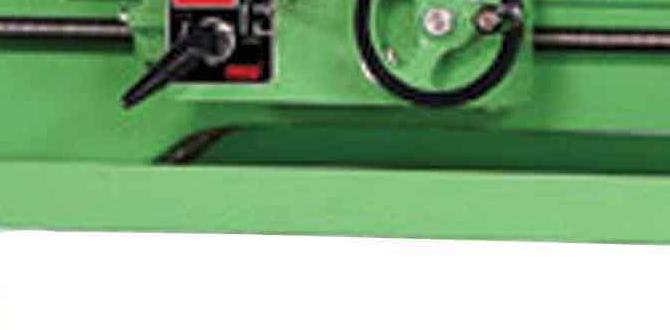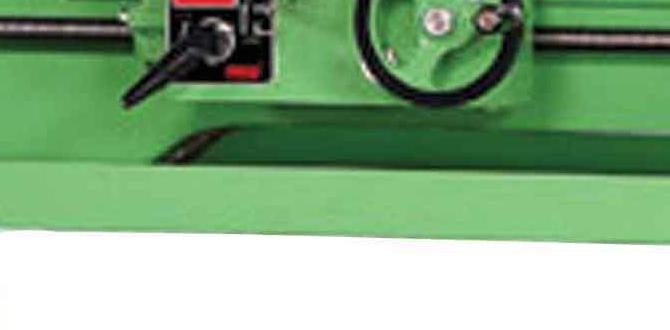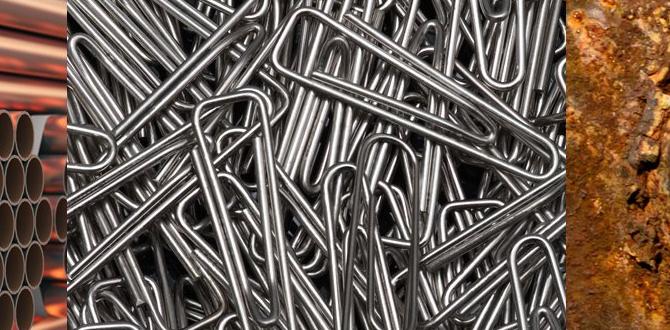For machining copper, carbide end mills generally offer superior performance due to their hardness and heat resistance, leading to faster speeds, better finishes, and longer tool life than High-Speed Steel (HSS) end mills. Choosing the right one depends on your specific needs, but carbide is often the preferred option for efficient and clean copper cuts.
Machining Copper: Choosing Your End Mill Friend
Hey there, fellow makers! Daniel Bates here from Lathe Hub. If you’ve ever tried to machine copper, you know it can be a bit… sticky. It’s a fantastic metal to work with for its conductivity and beauty, but it likes to cling and can be tough on your tools. One of the biggest questions for beginners is: “Which end mill should I use?” It boils down to two main types: High-Speed Steel (HSS), classic and reliable, and Carbide, the modern powerhouse. Picking the right one can make the difference between a frustrating mess and a beautifully cut part. Don’t worry, we’ll break it down, step-by-step, so you can confidently choose the best tool for your copper projects.
Understanding Your End Mill Options
When you look at end mills, you’ll mostly see them made from two materials: High-Speed Steel (HSS) and Tungsten Carbide. Both have their strengths and weaknesses, and knowing them is key when you’re working with a material like copper. Let’s get to know them a little better.
High-Speed Steel (HSS) End Mills
HSS is the traditional workhorse of machining. It’s a type of tool steel known for its toughness and ability to maintain its hardness even at higher temperatures, though “higher” is relative compared to carbide. Think of it as the reliable friend who always shows up.
Pros of HSS for Copper:
- Cost-Effective: HSS end mills are generally less expensive to buy, which is great for hobbyists or those just starting out.
- Toughness: They are more resistant to chipping and breaking, especially if you’re new to CNC machining or milling. This means they can handle minor setbacks without catastrophic failure.
- Flexibility: Available in a vast range of sizes and geometries.
Cons of HSS for Copper:
- Lower Cutting Speeds: HSS can’t handle the same high speeds as carbide. Pushing them too fast will generate excessive heat and reduce tool life dramatically.
- Softer & Weaker: Compared to carbide, HSS is softer. This means it will wear out faster when cutting tough materials or when used aggressively.
- Heat Buildup: Copper tends to be “gummy” when machined. HSS struggles to dissipate the heat generated, leading to tool wear and potential workpiece melting or sticking.
Carbide (Tungsten Carbide) End Mills
Carbide end mills are made from tungsten carbide powder that’s sintered with a binder (usually cobalt). This creates an extremely hard and rigid material. Think of carbide as the high-performance athlete – fast, precise, and built for demanding tasks.
Pros of Carbide for Copper:
- Superior Hardness and Rigidity: Carbide is significantly harder than HSS. This allows it to maintain a sharp edge for much longer, even at higher cutting speeds and feeds.
- Higher Cutting Speeds: You can run carbide tools much faster. This means quicker machining times and increased productivity.
- Better Heat Resistance: Carbide handles heat much better than HSS. This is crucial for gummy materials like copper, as it helps prevent heat buildup that can lead to tool damage and poor finishes.
- Excellent Surface Finish: Due to their rigidity and ability to stay sharp, carbide end mills often provide a cleaner, smoother finish on copper parts.
Cons of Carbide for Copper:
-
- More Brittle: While hard, carbide is also more brittle than HSS. It’s more prone to chipping or breaking if subjected to shock or excessive force. Careful setup and operation are a must.
- Higher Cost: Carbide end mills are generally more expensive upfront than their HSS counterparts.
<li><&strong>Less Tolerant of Misalignment: Due to their brittleness, they require accurate machine setup and alignment. Poor tramming or runout can quickly damage a carbide tool.
Why Copper Gives Tools a Hard Time
Copper isn’t like steel or aluminum. It’s a softer, more ductile metal, which means it has a tendency to deform rather than break cleanly when cut. This can lead to several issues when machining:
-
- Galling and Welding: The most common problem is “galling” or “built-up edge” (BUE). Copper can stick to the cutting edge of the tool, as if it’s welding itself on. This creates a dull edge, leading to poor surface finish, increased cutting forces, and even tool breakage.
- Heat Generation: The friction and deformation during cutting generate a lot of heat. If this heat isn’t managed, it can soften the tool material, causing premature wear, and can even melt the “chips” (the material being cut off), making them stickier and harder to clear.
Poor Chip Evacuation: The soft coppery chips tend to clump together and can clog the flutes of the end mill, leading to chip recutting and a rough surface finish.
These characteristics mean that your tool choice and machining strategy are extra important when working with copper.
Carbide End Mill vs HSS End Mill for Copper: The Verdict
So, when it comes to machining copper, which one wins the race? For most applications, especially if you’re aiming for efficiency, a good surface finish, and longevity, carbide end mills are generally the superior choice for copper.
Here’s why they often outperform HSS:
Speed and Efficiency
Carbide’s hardness allows you to run much higher spindle speeds and feed rates compared to HSS. This translates directly into faster machining times. For production environments or if you just want to get your project done quicker, carbide is the clear winner.
Surface Finish
The rigidity of carbide end mills allows them to maintain a sharp edge for longer. This precision cutting results in a much smoother and cleaner surface finish on the copper. Less galling, less tearing, and more of a polished look straight off the mill.
Tool Life
While carbide has a higher upfront cost, its superior hardness and heat resistance mean it will typically last much longer than an HSS end mill when cutting copper. If you’re doing a lot of copper machining, the extended tool life of carbide can make it more cost-effective in the long run.
Heat Management
While copper generates heat, carbide’s ability to withstand higher temperatures makes it less susceptible to softening and wear. This is a critical advantage over HSS, which can overheat quickly when machining gummy materials.
However, there are situations where HSS might still be considered:
When HSS Might Be Okay
Very Light Finishing Passes: For a very light, final finishing pass where speed isn’t a concern, a sharp HSS cutter might still provide a decent finish.
Budget Constraints: If your budget is extremely tight and you only have a small one-off job, an HSS end mill might be a more accessible option, provided you use very conservative cutting parameters.
Low-Power Machines: If your milling machine has very limited spindle speed or power, you might be forced to run HSS at speeds where carbide wouldn’t be effective anyway.
Ultimately, for consistent, efficient, and high-quality results when machining copper, carbide end mills are generally the go-to. A good quality carbide end mill designed for non-ferrous metals is your best bet.
Key Features to Look for in a Copper-Milling End Mill
When you’re selecting an end mill specifically for copper, certain features can make a big difference because of copper’s unique machining behavior. Both carbide and HSS tools can have these features, but they are especially beneficial on carbide for copper.
Flute Design
High Helix Angle: End mills with a high helix angle (often 30 degrees or more) are designed to “slice” through the material rather than “smash” it. This provides a smoother cut, reduces cutting forces, and helps in ejecting chips more effectively, which is great for gummy materials like copper.
Polished Flutes: End mills with highly polished flutes (especially carbide) have a smoother surface. This reduces friction and makes it harder for copper chips to stick (galling).
Number of Flutes
2-Flute End Mills: For machining softer, gummy materials like copper, brass, and aluminum, 2-flute end mills are often preferred. The increased chip clearance between the flutes allows for better chip evacuation and reduces the risk of chip recutting and clogging.
3-Flute End Mills: These can also work if chip evacuation is managed well, offering a smoother finish than 4-flute. They are often good all-rounders.
4-Flute End Mills: Generally used for harder materials or when a very fine finish is needed in steels or aluminum. They have less chip clearance, so they can be problematic with copper if not set up correctly.
Coatings
While often not necessary for softer metals like copper, some coatings can offer benefits. However, for copper, a plain, polished carbide tool often performs best. Avoid coatings designed for high-temperature alloys.
Material Specificity
Look for end mills marketed for “non-ferrous” metals or specifically for “aluminum and plastics.” These are usually designed with the geometry and polished flutes best suited for materials like copper.
Essential Machining Setup and Process for Copper
Even with the right tool, how you machine copper is just as important. Here are some best practices to ensure success:
Workholding is Crucial
Secure Clamping: Copper is soft and can deform. Ensure your workpiece is held very securely to prevent vibration or movement. Use clamps, vices, or fixtures that distribute pressure evenly. Avoid localized high pressure that could dent the material.
Support: If machining thin sections, consider using support or backing materials to prevent distortion.
Coolant and Lubrication
Essential for Copper: Machining copper without coolant or a lubricant is asking for trouble with galling. It helps reduce friction, dissipate heat, and flush away chips.
Recommended Coolants:
Specific Copper/Aluminum Lubricants: Many specialized cutting fluids designed for non-ferrous metals work very well.
Light Machine Oil: A light mineral oil or even WD-40 (though not a true coolant) can help prevent galling in lighter cuts.
Soluble Oils: Diluted soluble oil coolants are a good option for most milling operations.
Cutting Parameters (Speeds and Feeds)
This is where carbide really shines. You can push it harder.
Spindle Speed (RPM): For carbide end mills in copper, you can often start in the range of 10,000 – 25,000+ RPM. Always check the tool manufacturer’s recommendations. Faster speeds help create smaller chips and reduce heat buildup per chip.
Feed Rate (IPM or mm/min): Aim for a chip load that is appropriate for the diameter of your end mill and the material. A good starting chip load for a 1/4″ carbide end mill in copper might be around 0.001″ – 0.003″. This means your feed rate will be (chip load) x (number of flutes) x (RPM). For example, a 1/4″ 2-flute carbide at 15,000 RPM with a 0.002″ chip load would be: 0.002 x 2 x 15000 = 60 IPM. It’s always best to find a chip load calculator online or consult your tool supplier.
Depth of Cut (DOC) and Width of Cut (WOC):
Light DOC/WOC: For roughing, you can take deeper cuts, but for finishing, light passes are best to achieve a good surface.
Elastomeric Hugging & Chip Thinning: For optimal chip thinning (which produces finer chips and reduces load), a lighter radial stepover (WOC) is often beneficial. This is where adaptive clearing toolpaths really shine, as they maintain a consistent chip load by varying the WOC.
Chip Evacuation
Air Blast or Coolant Jet: Use an air blast or a strong jet of coolant directed at the cutting zone to forcefully blow chips away from the cutter and out of the flutes.
Pecking: For deep pockets, you might need to “peck” the tool out of the hole periodically to clear chips.
Checking out resources like the National Institute of Standards and Technology (NIST) can provide insights into machining data, though always start with tool manufacturer recommendations for specific geometry.
Comparison Table: Carbide vs. HSS for Copper Machining
Here’s a quick comparison to help you decide:
<






